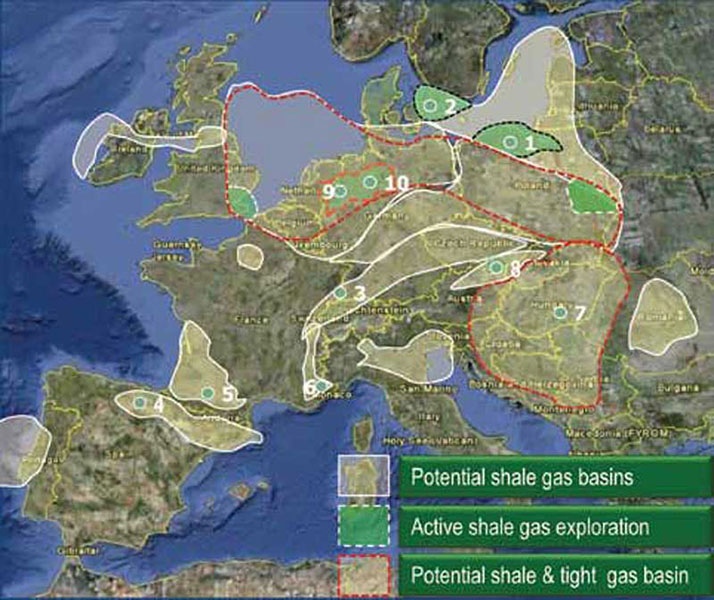Deeper targets, higher excitement: Industry enthusiasm for shale gas (and oil) plays just keeps escalating – and the interest is going global.

Shale gas exploration is no longer just a U.S. priority – countries around the world are joining the hunt, including some areas in Europe that hold huge potential.
Industry enthusiasm for shale gas (and oil) plays just keeps escalating – despite challenges from some who question the safety of hydraulic fracturing technology – and the interest is going global.
Shale action is now acquiring a foothold internationally, where hopes are high for perhaps a repeat of what is happening domestically.
Shale or unconventional gas potential reportedly has been identified in numerous regions outside the United States:
- Canada.
- Europe, including Austria, France, Germany, Hungary, Italy, Poland, Netherlands, Romania, Spain, Sweden, Switzerland and the United Kingdom.
- China.
- South Africa.
- Morocco.
- Russia.
- Ukraine
In the United States, international firms have been striking deals with American companies who are high up the learning curve in shale drilling, completion and production. This will provide the overseas companies with considerable expertise to utilize back home.
This expertise will be a must-have when taking on the shales in other countries.
“There’s certain technologies, especially on the completion side in horizontal well multi-stage completions, that are being done in North America,” said Chris Hopkins, vice president of unconventional resources at Schlumberger.
“A lot of these shale deals are to try and understand those techniques to use them overseas.”
Don’t lump all shales together. These are mighty quirky rocks with lots of variable characteristics, including TOC, porosity, brittleness, indigenous fracturing, etc.
“The high level of activity has not necessarily optimized developments in the North American shale basins because each of the shale plays is unique,” Hopkins said. “The well factory approach attempts to make one size fit all.
“While the shale plays are attracting the most attention, the challenges of other unconventional reservoirs are similar,” he noted. “Intense competition and steep learning curves mean success is not guaranteed, especially when the outlook for natural gas prices remains so uncertain and technology is advancing rapidly.”
A New Game

Chris Hopkins will present the luncheon talk, “Global Challenges in Shale Reservoir Development: Why a Statistical Approach Won’t Work,” at 11:30 a.m. Tuesday, Sept. 14, at the AAPG International Conference and Exhibition in Calgary.
Hitting it big in shales overseas will require a lot of homework – and some dogged determination.
Internationally one must actually explore for the shales, which is a one-eighty from the domestic scene. In the United States, numerous wells have drilled through shales over the years on the way to other targets, so it’s unnecessary to explore for them.
“No one (internationally) has really explored for unconventional shale before,” Hopkins said. “How do you find the sweet spots when you have a million acres leased on land, say, in Poland, and you can drill three wells, yet only five wells have drilled through it in the last 100 years? Where do you go?
“It will take a lot more upfront geological and geophysical understanding and drilling a few exploration type wells to understand what are the sweet spots, what is the driving facies,” Hopkins said.
“The best facies are different in all the different shales in the U.S., so you expect it to be the same way internationally,” he noted.
“You don’t look for siliceous facies in the Bakken shale, for instance, because that might not be the best.”
Challenges and Drivers
There’s potential for considerable seismic activity overseas. Much of this will be the less expensive 2-D to home in on promising areas; smaller 3-D shoots will then be implemented only in these locales to minimize cost.
Hopkins emphasized that the limited availability of seismic and well data overseas compared to North America will require a much more structured approach to exploration and delineation.
Market drivers, infrastructure and geopolitical issues will influence the expansion of unconventional plays overseas.
“The key driver is political,” Hopkins said, “governments who want to embrace it and push for it. That drive will be needed initially to get things moving.
“It’s for the indigenous natural gas source as opposed to imports,” he noted, “and that will allow good leasing terms, so that’s the number one issue.
“Then there’s the resource itself, whether you have it or not,” Hopkins continued.
“The presence or absence of service infrastructure and whether or not you can build this properly is another issue to be dealt with,” he said, “as are environmental concerns.
“Shale E&P won’t be easy overseas,” he said, “but maybe easier in some countries than others.”